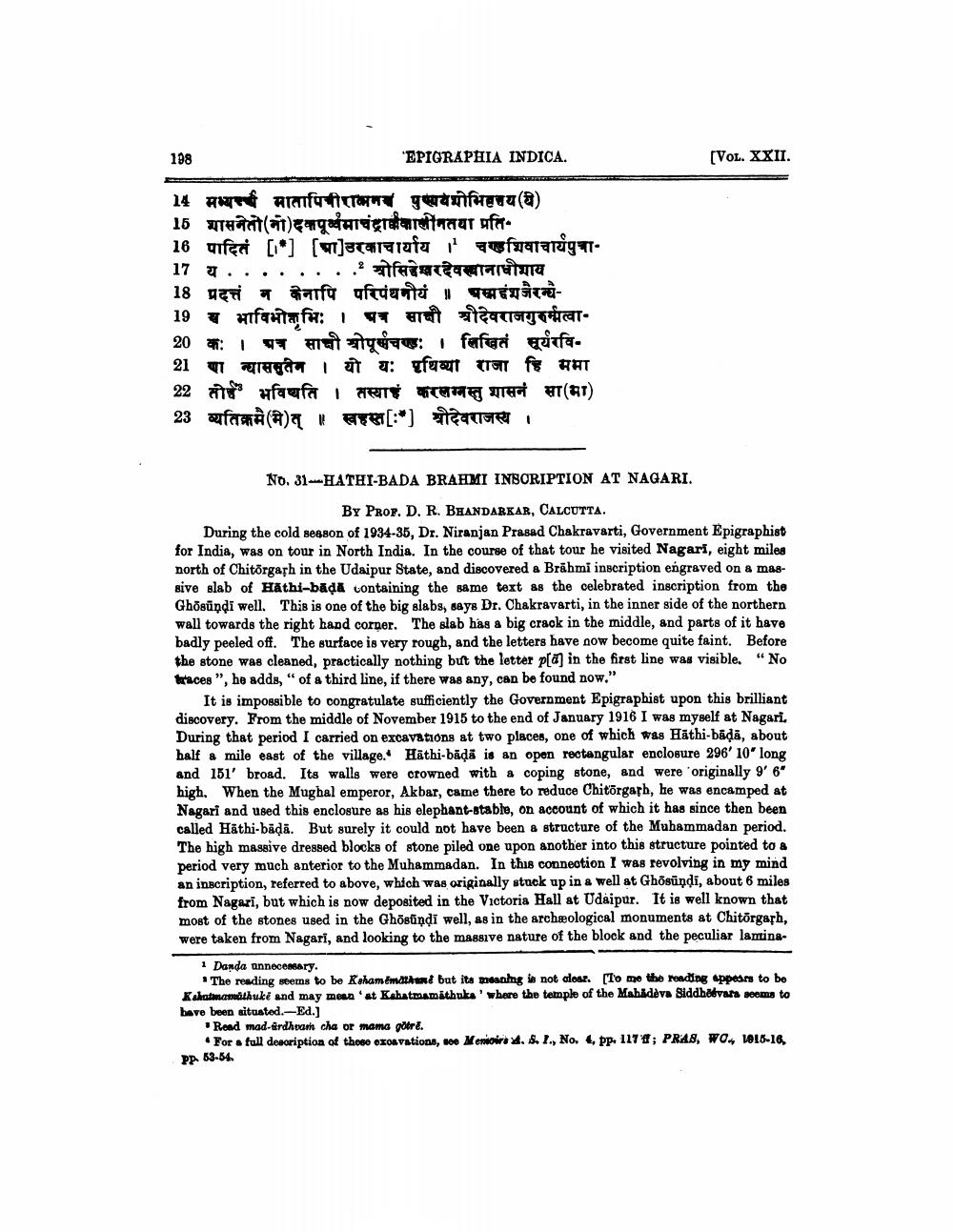________________
198
"EPIGRAPHIA INDICA.
(VOL. XXII.
14 मध्यर्ष मातापित्रीरामन पुस्खयेशोभिचय(2) 15 märt(at)
e SATSigaar waar afge 16 ufri [*] (M]Tarife i tufwata 17 J........ fratern a 18 new o rfo ofrdanti TRT19 च भाविभोक्तभिः । पत्र साक्षी श्रीदेवराजगुरुन्मत्वा20 : 9 He syg: 1 fafaa sifa. 21 या न्यासमुतन । यो यः पृथिव्या राजा हि ममा 22 online waufa RTS Herna med (#1) 23 fak() # FEET[:*) teatrore
No. 31-HATHI-BADA BRAHIMI INSCRIPTION AT NAGARI.
BY PROF. D. R. BHANDARKAR, CALCUTTA. During the cold season of 1934-36, Dr. Niranjan Prasad Chakravarti, Government Epigraphist for India, was on tour in North India. In the course of that tour he visited Nagari, eight miles north of Chitorgarh in the Udaipur State, and discovered a Brahmi inscription engraved on a mas sive slab of Hāthi-bāda containing the same text as the celebrated inscription from the Ghősündi well. This is one of the big slabs, says Dr. Chakravarti, in the inner side of the northern wall towards the right hand corner. The slab has a big crack in the middle, and parts of it have badly peeled off. The surface is very rough, and the letters have now become quite faint. Before the stone was cleaned, practically nothing but the letter play in the first line was visible. “No traces", he adds," of a third line, if there was any, can be found now."
It is impossible to congratulate sufficiently the Government Epigraphist upon this brilliant discovery. From the middle of November 1915 to the end of January 1916 I was myself at Nagari. During that period I carried on excavations at two places, one of which was Häthi-bādā, about half a mile east of the village. Häthi-bāda is an open rectangular enclosure 296' 10' long and 151' broad. Its walls were crowned with a coping stone, and were originally 9' 6" high. When the Mughal emperor, Akbar, came there to reduce Chitorgarh, he was encamped at Nagari and used this enclosure as his elephant-stable, on account of which it has since then been called Hathi-bādā. But surely it could not have been a structure of the Muhammadan period. The high massive dressed blocks of stone piled one upon another into this structure pointed to a period very much anterior to the Muhammadan. In this connection I was revolving in my mind an inscription, referred to above, which was originally stuck up in a well at Ghosündi, about 6 miles from Nagari, but which is now deposited in the Victoria Hall at Udaipur. It is well known that most of the stones used in the Ghösundi well, as in the archæological monuments at Chitorgash, were taken from Nagari, and looking to the massive nature of the block and the peculiar lamina
Danda annecessary. * The reading seems to be Kshamematend but its meaning is not clear. [To me the reading appears to be Keka.mahuki and may men at Kahatmamathuka' where the temple of the Mahadeva Siddhodvars seems to have been situated.-Ed.]
Read mad-ardhean cha or mama gore.
For a full desoription of those oxoavations, soe Menoin 4. 8. I., No. 4, pp. 1174; PRAS, Wo. 1916-16. PP 53-84.




